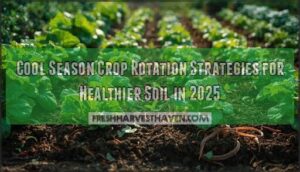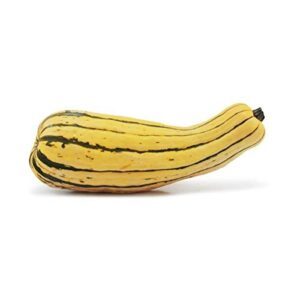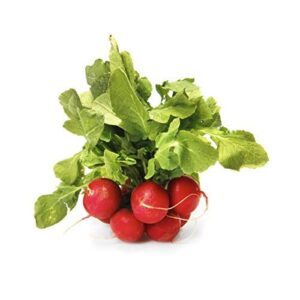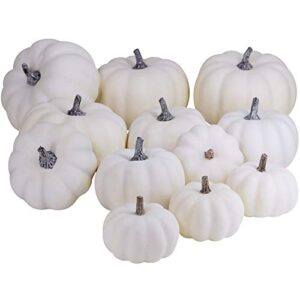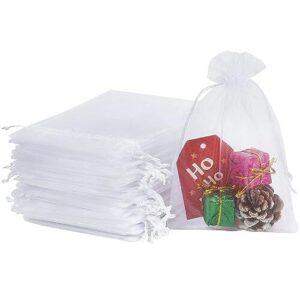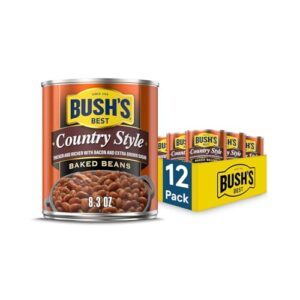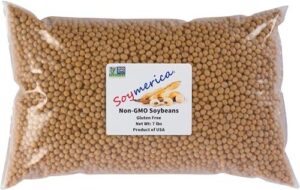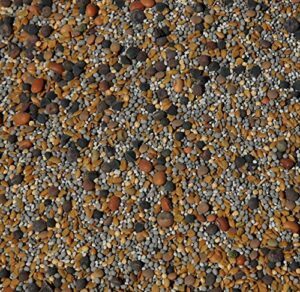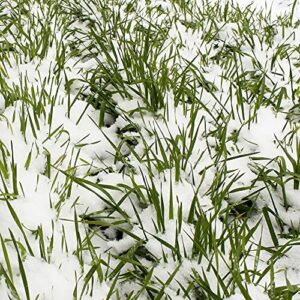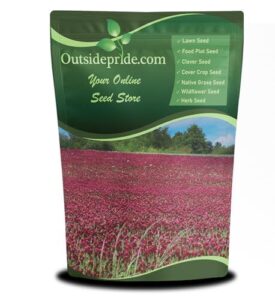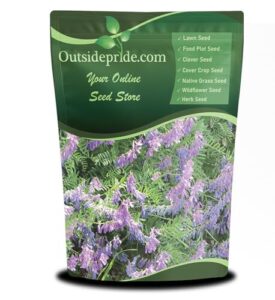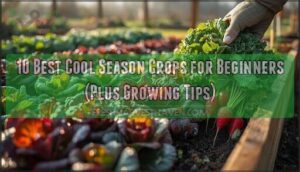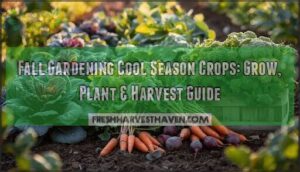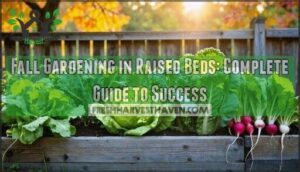This site is supported by our readers. We may earn a commission, at no cost to you, if you purchase through links.
Your cool season garden isn’t just fighting winter—it’s fighting the ghosts of last year’s crops. Every brassica you plant in the same spot compounds disease pressure, while each successive planting of legumes leaves the soil hungrier than before.
The pattern holds across climates and garden sizes: rotation breaks these cycles, and the farms that master it see yields jump 20-30% while cutting fertilizer costs in half.
The secret isn’t complicated crop science—it’s understanding how different plant families interact with your soil’s living ecosystem. When you rotate cool season crops strategically, you’re fundamentally hiring nature’s cleanup crew to reset your garden between harvests, building fertility instead of depleting it.
Table Of Contents
- Key Principles of Cool Season Crop Rotation
- Designing Effective Seasonal Planting Schedules
- Enhancing Soil Health and Pest Control
- Winter Preparation and Harvest Optimization
- Top 10 Products for Cool Season Crop Rotation
- 1. Organic Fresh Delicata Winter Squash
- 2. Root Radish Red Organic Fresh Bunch
- 3. White Artificial Pumpkin Decorations Set
- 4. White Organza Gift Bags Set
- 5. Country Style Baked Beans Pack
- 6. Non Gmo Usa Soybeans Bulk
- 7. No Till Cover Crop Mix
- 8. Non Gmo Winter Rye Seeds
- 9. Crimson Clover Ground Cover Seeds
- 10. Hairy Vetch Cover Crop Seeds
- Frequently Asked Questions (FAQs)
- Conclusion
Key Principles of Cool Season Crop Rotation
Cool season crop rotation isn’t just about swapping plants around—it’s about understanding how different crops interact with your soil and why the order matters. When you grasp the underlying principles, you’ll make smarter decisions that protect soil fertility, disrupt pest cycles, and set up each crop for success.
Let’s break down the core concepts that make rotation work in your favor.
Understanding Crop Families and Nutrient Needs
Understanding your crops’ botanical families unlocks better soil health and rotation planning. You’ll want to track at least eight major families—Brassicaceae, Fabaceae, Solanaceae, and others—since each has distinct nutrient needs.
Brassicas demand 120–160 lb/acre nitrogen, while legumes fix up to 200 lb/acre but deplete phosphorus. Root system diversity improves soil mineral availability by 25%, making family-based rotation essential for sustainable management benchmarks.
Rotating crops can reduce disease risk, leading to healthier soil.
Preventing Soil Nutrient Depletion
Nutrient cycling through careful crop sequencing stops your soil from losing what it needs most. When you rotate cereals with legumes and cover crops, you’ll see nitrogen rise by 45–81 kg/ha per cycle—about 20–40% more available for subsequent plantings.
That’s why soil health improves when you avoid nutrient mining: different crops pull and return different minerals, balancing what conventional monoculture depletes season after season. This approach greatly improves soil structure and increases water infiltration.
Breaking Pest and Disease Cycles
Rotating your cool season crops starves crop-specific pests and breaks disease cycles that monoculture perpetuates. Alternating brassicas with non-host crops like cereals can reduce pest populations by up to 80%, cutting disease incidence by 66% in legume rotations.
That’s biological soil enhancement driving economic pest management—fewer chemical inputs, better IPM outcomes. You’ll disrupt pest lifecycle progression naturally while lowering treatment costs and improving long-term field resilience.
Planning Multi-Year Rotation Schedules
Building on that pest suppression success, you’ll want a multi-year rotation schedule spanning 3 to 8 years to optimize nutrient balance and economic viability. Here’s your planning framework:
- Map each year’s crop sequencing by family rotation
- Alternate deep-rooted and shallow-rooted species strategically
- Position legumes after heavy nitrogen feeders
- Integrate cover crops during off-seasons
- Track nutrient inputs and yield responses annually
Rotation length directly influences soil health—diverse 4-year systems boost organic matter 16-32% while improving pest management outcomes.
Designing Effective Seasonal Planting Schedules
A well-designed planting schedule turns crop rotation theory into practical action throughout the growing season. You’ll need to sequence your cool season crops thoughtfully, integrate soil-building plants between harvests, and adapt your timing to match your local climate’s unique rhythms.
Whether you’re managing a backyard garden or several acres, the following strategies will help you create a rotation plan that builds soil health year after year.
Mapping Out Cool Season Crop Successions
You can think of mapping crop successions like orchestrating a relay race—timing matters. Start by charting staggered planting schedules at 7 to 21-day intervals for continuous harvests.
Climate adaptation shapes your planting schedule; use local frost dates to guide succession timing. Variety selection with different maturity dates extends harvest windows, while soil management records help improve future crop rotation strategies for best seasonal performance.
Incorporating Cover Crops and Green Manures
Between your main crops, you can utilize cover crops and green manures to rebuild soil carbon sequestration while slashing erosion control challenges. Legumes offer nitrogen fixation benefits, while non-legumes excel at nutrient cycling and biomass production.
Crimson clover and hairy vetch improve soil health through enhanced organic matter, supporting your crop rotation goals and reducing fertilizer dependence season after season.
Aligning Crop Rotation With Local Climate Patterns
How do you match your rotation plan to the specific rhythm of your climate zone? Your seasonal planting schedules thrive when you integrate frost dates and regional weather patterns into every decision. Climate data integration and variety selection determine which crops succeed under your seasonal growing conditions.
- Track frost dates to time cool-season plantings accurately
- Select varieties matching your temperature and moisture patterns
- Create microclimate zones using windbreaks for expanded options
- Make seasonal adjustments based on documented weather trends
- Align planting dates with market alignment opportunities for profitability
Adjusting Schedules for Small and Large Gardens
Does your garden’s size dictate how you build your rotation framework? Spatial restrictions in small-space gardens demand rotation flexibility through container swaps and divided bed sections, while larger plots support structured three- to four-year schedules that improve disease management.
Planning crop rotation across different scales requires adjusting your schedule structure—small gardens emphasize seasonal crop rotation with heavy soil amendments, whereas expansive spaces cycle crop families methodically for long-term productivity and improving soil health through strategic cover cropping and extended rest periods.
Enhancing Soil Health and Pest Control
Crop rotation isn’t just about preventing nutrient depletion—it’s your most effective tool for building resilient soil and managing pests without reaching for chemical solutions. When you rotate cool season crops strategically, you’re setting in motion natural processes that improve soil structure, break pest cycles, and balance nutrient availability across growing seasons.
Let’s look at four key ways rotation enhances both soil health and pest management in your garden or farm.
Improving Soil Structure and Organic Matter
Healthy soil structure acts like a sponge—it holds water, bolsters roots, and breathes life into your crops. When you rotate cool season crops with diverse root systems and incorporate cover crops, you’re building soil organic matter that boosts aggregate stability and water retention while lowering bulk density.
- Carbon sequestration jumps to 2.03 t C ha⁻¹ yr⁻¹ in diversified legume-cereal rotations over six years
- Aggregate stability improves measurably after three consecutive cover crop cycles, reducing erosion risk
- Soil porosity increases as deep-rooted covers break compaction and improve aeration below 20 cm
Reducing Pest and Disease Pressure Naturally
When you rotate cool season crops, you’re basically pulling the rug out from under pests and pathogens—breaking their cycles before they establish strongholds. Crop diversity benefits include up to 60% reductions in pest pressures and 20% lower disease severity in diversified rotations compared to monoculture.
Rotating cool season crops starves pests of their host plants, cutting pest pressure by 60% and disease severity by 20%
Rotation tillage impact extends to beneficial insect habitats, where predatory beetle populations jump 43%, strengthening natural pest control without chemical dependency.
Managing Nitrogen and Other Nutrients
Cool season crop rotation gives you a powerful lever for nitrogen management—you’re practically orchestrating nutrient cycling benefits that synthetic inputs can’t replicate. Legume nitrogen fixation can boost soil nitrogen by 20-40%, while smart rotation improves nitrogen use efficiency and cuts leaching impact.
- Split nitrogen applications timed to peak uptake periods (3-5 lb N per acre daily) boost efficiency
- Monitor soil mineralization rates to align fertilizer placement with crop demand windows
- Deep-rooted rotational crops capture residual nitrates, protecting groundwater quality
Promoting Biodiversity Through Crop Diversity
Beyond nutrient cycling, you’re fostering a living ecosystem. Diversified crop rotation boosts fungal diversity and microbial richness, strengthening pest suppression while improving yield stability. When you include at least three crops plus cover crops, you’ll see measurable gains in ecosystem services—from pollinator habitats to soil carbon sequestration.
| Rotation Strategy | Biodiversity Benefit |
|---|---|
| 2-species mixtures | 27% yield increase over monocultures |
| 4-species mixtures | 49% yield increase, enhanced soil microbial activity |
| Legume inclusion | Complementary pest control, reduced pesticide dependence |
| Ley pasture integration | Greater fungal diversity, improved soil structure |
| Cover crop overwintering | 40% erosion reduction, higher bacterial richness |
This approach transforms your field into a self-regulating system that sustains sustainable agriculture.
Winter Preparation and Harvest Optimization
As cool season crops near maturity, your focus shifts from growth to protection and productivity. Winter preparation involves choosing the right crops to shield your soil, timing your harvest to capture peak yields, and preparing fields for the next rotation cycle.
Let’s walk through the essential practices that bridge the gap between harvest and replanting.
Selecting Crops for Erosion Control
During winter preparation, cover crop selection for erosion control hinges on root biomass and soil stabilization capacity. You’ll want to choose winter cover crops that deliver substantial erosion reduction while building soil health for your spring plantings.
- Hairy vetch extends roots up to 3 feet deep, anchoring soil and cutting soil erosion by over 50%
- Crimson clover and radishes generate 0.4 to 5.0 Mg ha⁻¹ root biomass, binding aggregates and improving water infiltration
- Winter rye and oats provide dense root networks that increase soil organic carbon by 22%, enhancing cohesion
- Deep-rooted varieties reinforce soil structure and reduce erodibility throughout dormant months
Timing Planting and Harvest for Maximum Yield
Maximizing harvest timing starts with planting when soil temperatures reach 40°F to 70°F and air temperatures stay between 50°F and 75°F during the growing season.
You’ll want to monitor photoperiod effects—extending light exposure to 16 hours can boost biomass by 20-30%, though higher temperatures around 25°C to 30°C may trigger early bolting.
Track harvest indicators like Brix levels for sugar content and size metrics to determine physiological maturity, ensuring best yield and quality from your crop rotation system.
Using Cover Crops to Protect and Enrich Soil
Establishing cover crops between harvest and replanting transforms your soil’s capacity to resist erosion while building organic matter. Legumes like hairy vetch or crimson clover fix atmospheric nitrogen—delivering 50 to 100 pounds per acre—while cereal rye and radishes trap residual nitrates and suppress weeds through allelopathic compounds.
You’ll see nutrient cycling improvements, pest suppression through beneficial insect habitat, and enhanced soil structure that fosters healthier crop rotation outcomes.
Post-Harvest Soil Preparation Techniques
Once you’ve brought in the harvest, conduct soil testing to measure nitrate-N levels and nutrient availability—most fields register around 24 kg ha⁻¹ post-harvest.
Balance tillage practices with residue management by incorporating crop residues to boost soil organic matter by up to 48% over multiple seasons.
Then establish cover cropping systems and apply targeted soil amendments to restore nutrients and protect exposed ground.
Top 10 Products for Cool Season Crop Rotation
Implementing a successful cool season crop rotation requires the right seeds, cover crops, and soil-building materials to support your goals. Whether you’re establishing winter ground cover, enriching your soil with legumes, or selecting crops that protect against erosion, your choices directly influence long-term productivity.
Here are ten products that can strengthen your rotation strategy and help you build healthier, more resilient soil throughout the cooler months.
1. Organic Fresh Delicata Winter Squash
Selecting the right varieties makes all the difference in your cool season crop rotation plan, and organic fresh delicata winter squash earns its place as a rotational cornerstone. You’ll appreciate its compact size and edible skin after roasting—qualities that ease harvest and reduce waste.
When stored properly, seasonal delicata maintains excellent delicata texture and delicata nutrition, though timing matters since availability peaks within specific windows. Roasting delicata with olive oil brings out natural sweetness while supporting your organic gardening goals.
This crop fits seamlessly into diverse rotation schedules, contributing to long-term soil health and crop selection diversity.
Best For: Home gardeners looking for an easy-to-grow winter squash that fits into organic crop rotation plans and offers edible skin with great roasted flavor.
- Compact size with edible skin makes it simple to roast whole or in pieces—no peeling required, which cuts down on prep time and waste.
- Fits naturally into diverse crop rotation schedules, helping improve soil health by up to 50% when rotated properly with other plant families.
- High-quality organic option that’s delicious on its own with just olive oil, salt, and pepper, or works well in recipes as a healthy snack.
- Seasonal availability means you can only get it during specific windows, so it’s not a year-round option.
- Texture can sometimes turn out dry and grainy, even when you buy it in season and prepare it correctly.
- Needs careful storage to avoid rot, and quality can be inconsistent depending on when and where it’s sourced.
2. Root Radish Red Organic Fresh Bunch
Few cool season root vegetables work as hard as organic fresh radish bunches to improve soil health between primary crop cycles. Their deep taproots break through compacted layers, enhancing water infiltration while extracting excess nitrates that might otherwise leach away.
Radishes thrive in light, sandy loam with a pH of 6.5–7.0 and temperatures between 50°F and 70°F, making them ideal for early spring or late summer planting schedules.
Their glucosinolates suppress nematodes and soil-borne pests naturally, supporting organic cultivation practices while contributing valuable organic matter upon decomposition.
Best For: Home gardeners and farmers looking for a nutrient-rich, organic root vegetable that doubles as a natural soil conditioner and pest management tool between growing seasons.
- Deep taproots naturally break up compacted soil and improve water infiltration, making them excellent for soil health restoration while providing fresh, nutritious produce.
- Natural pest control through glucosinolates that suppress nematodes and soil-borne diseases, reducing the need for chemical interventions in organic gardens.
- Quick-growing cool season crop that thrives in spring and fall temperatures (50°F-70°F), allowing for multiple successive plantings and continuous harvest throughout the season.
- Often arrives with sand or mud on leaves and roots, requiring thorough washing before use, which can be time-consuming.
- Quality and texture can be inconsistent, with some radishes developing a woody texture, particularly larger ones that don’t always indicate better eating quality.
- Priced higher at $2.79 per bunch compared to bagged options available at typical grocery stores, which may not suit budget-conscious shoppers.
3. White Artificial Pumpkin Decorations Set
Market trends in decorative agriculture have generated a curious product: white artificial pumpkin decorations. These items are now facing pricing analysis, with retail costs jumping 115% in 2025 due to shifting consumer preferences toward “spooky-chic” decor aesthetics.
While these foam and plastic sets offer material quality suitable for multi-year display, their environmental impact contrasts sharply with living cover crops and winter crops that genuinely support soil fertility.
You won’t better soil health through ornamental substitutes—focus your resources on strategies that improve actual crop rotation systems instead.
Best For: Homeowners and decorators looking for versatile, reusable fall decor that works across Halloween and Thanksgiving without the mess of real pumpkins.
- Multi-year durability means you can reuse them season after season, making them cost-effective over time compared to buying fresh pumpkins annually.
- The whitewashed color fits modern “spooky-chic” trends and works with almost any decor style, from rustic farmhouse to minimalist.
- No rotting, bugs, or cleanup hassle—just pull them out each fall and you’re done.
- Quality can be hit or miss, with some pieces arriving with dents, chips, or loose tops that don’t stay attached properly.
- They’re pretty small (2.5 to 4 inches), which might disappoint if you’re expecting statement pieces for a large display.
- Made from non-biodegradable foam and plastic, so they’re not the greenest choice if sustainability matters to you.
4. White Organza Gift Bags Set
You might overlook something as simple as white organza gift bags, but their breathable mesh fulfills dual purposes in cool season crop rotation. These reusable bags function as a pest barrier for ripening fruits while protecting harvests from insect damage without chemical inputs.
Their cost efficiency improves when purchased in bulk, and unlike single-use plastics, their reusability aligns with sustainable practices that complement cover crops and soil fertility goals.
While they don’t directly amend soil health, they reduce pest pressures during critical harvest windows.
Best For: Small-scale farmers and home gardeners looking for a reusable, chemical-free way to protect ripening fruits and vegetables from pests while maintaining sustainable growing practices.
- Breathable mesh design allows air, water, and light through while creating an effective barrier against insects, birds, and weather damage without pesticides
- Highly reusable and cost-effective when bought in bulk, offering long-term savings compared to disposable plastic alternatives
- Versatile beyond crop protection—works great for seed saving, storing small garden items, and even doubles as attractive packaging for farmers market sales
- Some bags may have minor stitching flaws that could affect durability over multiple growing seasons
- The 4×6 inch size might not fit larger fruits or vegetables, limiting which crops you can protect
- Material can discolor to a gold tone after prolonged outdoor exposure to sun and weather
5. Country Style Baked Beans Pack
You won’t find Country Style Baked Beans contributing directly to soil health or crop rotation, but they offer practical value when meal planning for farm labor during harvest season. Each 8.3 oz can provides 12g of protein and 7g of fiber—nutritional efficiency that matters when you’re managing long planting or harvest days.
The gluten-free, shelf-stable packaging ensures food security without refrigeration, reducing waste. While unrelated to sustainable farming practices like cover crops or pest pressures management, their convenience bolsters the human side of agricultural operations efficiently.
Best For: Farm workers, outdoor laborers, or anyone needing a quick, protein-rich side dish that doesn’t require refrigeration until opened.
- High protein (12g) and fiber (7g) per serving make it a filling, nutritious option for long workdays
- Shelf-stable cans are convenient for remote locations, jobsites, or emergency food supplies
- Gluten-free and 97% fat-free fits multiple dietary needs without sacrificing flavor
- Sodium content (500-640mg per serving) may be high for those watching salt intake
- Some customers report receiving damaged cans during shipping
- Bean content can cause digestive discomfort for some people
6. Non Gmo Usa Soybeans Bulk
Beyond the dining table, legumes like non-GMO USA soybeans bring tangible benefits to your crop rotation systems. As nitrogen-fixing plants, soybeans replenish soil health naturally, reducing synthetic fertilizer dependency—a cornerstone of sustainable farming practices.
In 2025, food-grade non-GMO soybeans command a $2.53 per bushel premium over conventional varieties, reflecting strong soybean market trends driven by identity-preserved traceability. Bulk pricing strategies make larger purchases economical for growers integrating legumes between cool season crops.
You’re not just rotating plants; you’re building resilient soil biology that fosters long-term productivity and agronomic stability.
Best For: Farmers and food processors seeking traceable, identity-preserved soybeans for tofu, soy milk, or tempeh production while earning premium prices and improving soil health through crop rotation.
- Earns a consistent $2.53 per bushel premium over conventional soybeans, with 92% of non-GMO acres sold at premium prices in 2024.
- Acts as a nitrogen-fixing crop that naturally replenishes soil health, reducing the need for synthetic fertilizers in rotation systems.
- Meets growing demand from domestic and international buyers, particularly in Japan, South Korea, and Taiwan, with 67% of food-grade acreage grown under contract in 2025.
- Non-GMO acreage declined 16% in 2024, suggesting potential supply chain challenges or shifting grower priorities.
- Export volumes dropped 17% in 2024 due to currency fluctuations like the weakened Japanese yen, affecting international competitiveness.
- Requires identity-preserved handling and strict traceability standards, which can add logistical complexity and costs compared to conventional soybeans.
7. No Till Cover Crop Mix
When you’re building soil health through crop rotation, the No-Till Solutions Cover Crop Mix delivers all 13 varieties you need in a single bag—from nitrogen-fixing legumes to deep-rooted radishes that break up compaction.
This diversity strengthens nutrient cycling, with no-till farming reducing soil erosion by up to 86%. You’ll improve soil structure while the biomass production smothers weeds and feeds microbes.
At $15.99 per pound, it’s a strategic investment in crop diversity that protects your ground during the off-season and sets the stage for healthier cool season crops.
Best For: Farmers and gardeners practicing no-till methods who want to rebuild soil health, suppress weeds naturally, and create a biodiverse ecosystem without relying on synthetic inputs.
- Combines 13 cover crop varieties in one mix, including nitrogen-fixing legumes and deep-rooted species that break compaction while reducing soil erosion by up to 86%.
- Inoculated with beneficial Rhizobium and supports diverse soil microbes, improving nutrient cycling and long-term fertility without chemical fertilizers.
- Provides natural weed suppression through dense biomass while attracting pollinators and beneficial predators to protect your crops.
- At $15.99 per pound, covering large acreage gets expensive quickly, and one bag may not stretch far for bigger gardens or fields.
- Requires moderate watering to establish properly, so it may struggle in dry climates or areas with intense sun without irrigation support.
- Birds and squirrels often eat the seed before it can reseed itself, meaning you’ll need to replant each season instead of letting it naturalize.
8. Non Gmo Winter Rye Seeds
Winter rye stands out as your go-to cover crop for late-season planting in cool-season rotations. Mountain Valley Seed Company’s Non-GMO Winter Rye Seeds germinate at soil temperatures as low as 35°F, making them ideal for establishing erosion control before snow flies.
You’ll get extensive root networks that break up compaction, reduce soil bulk density, and provide over 70% weed suppression through allelopathy. At roughly 90,000 seeds per five-pound bag, you’re investing in proven soil health improvements that protect nutrients during winter and set up your spring crop rotation for success.
Best For: Farmers and gardeners looking to improve soil health during the off-season, especially those working with compacted or nutrient-depleted fields in cold climates.
- Germinates in soil as cold as 35°F and survives freezing temperatures, giving you flexibility to plant late into fall without sacrificing spring performance.
- Delivers serious soil benefits through deep roots that break up compaction, suppress weeds by over 70%, and reduce nutrient runoff all winter long.
- Contains roughly 90,000 seeds per 5-lb bag with high germination rates, offering excellent coverage for the price compared to hybrid alternatives.
- Some users reported lower germination rates than expected, so results may vary depending on your soil conditions and planting timing.
- Requires careful termination timing (7-10 days before planting your next crop) to avoid allelopathic effects on small-seeded plants.
- May cost more upfront than conventional cover crop options, though the soil health returns typically justify the investment over multiple seasons.
9. Crimson Clover Ground Cover Seeds
Crimson clover delivers vigorous nitrogen fixation—30 to 125 pounds per acre—while reducing soil erosion by up to 90% through its dense fibrous root system. This legume enriches your soil health management strategy by building organic matter and supporting pollinators, seamlessly integrating into cool-season crop rotation schedules.
You’ll appreciate how Outsidepride’s Nitrocoated and inoculated seeds guarantee strong seed germination above 60°F, establishing thick ground cover that suppresses weeds by 40 to 60%. It’s green manures at their finest, transforming winter fallow periods into active soil-building opportunities.
Best For: Farmers and landowners looking to boost soil nitrogen naturally, control erosion on vulnerable terrain, and support pollinators while keeping weeds in check during off-season months.
- Fixes 30-125 lbs of nitrogen per acre and cuts erosion risk by up to 90%, making it a powerhouse for soil health without synthetic inputs.
- Nitrocoated and inoculated seeds deliver reliable germination and rapid establishment, creating dense cover that suppresses weeds by 40-60%.
- Attracts pollinators during bloom and provides 16-22% crude protein forage, supporting both wildlife and livestock while building organic matter.
- Annual lifecycle means you’ll need to replant each year rather than enjoying perennial benefits.
- Requires soil temps above 60°F to germinate, limiting planting windows in cooler climates or early spring conditions.
- Some users reported inconsistent seed mixtures and germination rates depending on weather and soil variables.
10. Hairy Vetch Cover Crop Seeds
Hairy vetch stands out among cover crops with its outstanding nitrogen fixation capacity—90 to 180 pounds per acre—directly aiding your soil health management and reducing fertilizer costs. This legume’s low C:N ratio accelerates nutrient cycling, while its sprawling vines provide effective weed suppression and erosion control.
For ideal seed selection, you’ll want 15 to 20 pounds per acre drilled at temperatures above 60°F. The vetch benefits extend beyond soil enrichment: residue aids beneficial predators, and its winter hardiness makes it ideal for diversified crop rotation schedules.
Best For: Farmers and gardeners looking to boost soil nitrogen naturally, cut fertilizer costs, and improve long-term soil health through a winter-hardy cover crop.
- Delivers 90–180 pounds of nitrogen per acre through biological fixation, significantly reducing or eliminating the need for commercial fertilizers in subsequent crops.
- Provides excellent weed suppression and erosion control with dense vine growth and rapid residue decomposition, thanks to its low carbon-to-nitrogen ratio.
- Winter-hardy and adaptable to various climates and soil types, making it a reliable option for diverse crop rotation systems while supporting beneficial insects and pollinator health.
- Hard seed dormancy can cause 10–20% of seeds to remain ungerminated and potentially become weeds in later seasons, requiring careful crop rotation planning.
- Heavy, sprawling vine biomass at termination can complicate mechanical management, especially if termination is delayed for maximum nitrogen contribution.
- Some users have reported inconsistent germination rates and challenges with customer service, and the crop requires proper timing and conditions (minimum 60°F soil temperature) for successful establishment.
Frequently Asked Questions (FAQs)
How do I rotate crops in raised beds?
You can divide your raised bed into four sections, rotating crop families annually—brassicas, nightshades, cucurbits, and root vegetables each occupy different zones. This prevents nutrient depletion while naturally suppressing pests.
Can crop rotation work in containers or pots?
Yes, crop rotation thrives in containers. Rotating crop families in pots reduces disease by up to 73%, improves nutrient cycling, and boosts yields by 18-25%.
Container benefits include enhanced soil recovery and effective pest management in small-space gardens.
What happens if I skip a rotation year?
Skipping rotation invites trouble: pest outbreaks surge, soil health declines, and nutrient deficits compound.
You’ll see yield reduction, increased crop failure risk, and accelerated soil erosion—basically undoing years of careful stewardship through one costly shortcut.
How does crop rotation affect watering schedules?
Different crops in your rotation have varying water needs—corn may demand more during pollination while wheat uses much less.
You’ll need to adjust irrigation planning and timing for each crop to boost water efficiency and maintain ideal soil moisture.
Should I rotate crops if using synthetic fertilizers?
Even with synthetic fertilizers, you’ll still need crop rotation. Synthetic inputs can’t replace rotation benefits like improved soil structure, reduced pest cycles, enhanced microbial diversity, better nutrient cycling, and prevention of micronutrient depletion over time.
Conclusion
Your garden’s transformation won’t happen overnight—it’ll unfold across seasons as cool season crop rotation strategies rebuild what years of monoculture depleted. Each rotation cycle compounds the benefits: disease pressure drops, nitrogen fixers replenish what heavy feeders consumed, and soil structure deepens with every cover crop.
The farms seeing those 30% yield increases didn’t stumble into success—they mapped their rotations like chess players thinking three moves ahead, letting biology do the heavy lifting.
- https://www.earthobservatory.nasa.gov/images/154601/how-to-rotate-crops
- https://www.sciencedirect.com/science/article/pii/S2590332220300889
- https://juniperpublishers.com/artoaj/ARTOAJ.MS.ID.556300.php
- https://www.sdsoilhealthcoalition.org/2023/05/long-term-research-reveals-advantages-of-diverse-crop-rotations/
- https://ilsustainableag.org/reap-what-you-sow-economic-benefits-of-cover-crop-transitions/

